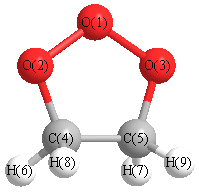Vibrational Frequencies calculated at CBS-Q
| Mode Number |
Symmetry |
Frequency
(cm-1) |
Scaled Frequency
(cm-1) |
IR Intensities
(km mol-1) |
Raman Act
(Å4/u) |
Dep P |
Dep U |
|---|
| 1 |
A' |
3328 |
3328 |
43.76 |
|
|
|
| 2 |
A' |
3253 |
3253 |
47.64 |
|
|
|
| 3 |
A' |
1665 |
1665 |
0.53 |
|
|
|
| 4 |
A' |
1500 |
1500 |
1.69 |
|
|
|
| 5 |
A' |
1365 |
1365 |
2.69 |
|
|
|
| 6 |
A' |
1192 |
1192 |
47.17 |
|
|
|
| 7 |
A' |
1068 |
1068 |
34.81 |
|
|
|
| 8 |
A' |
1027 |
1027 |
10.51 |
|
|
|
| 9 |
A' |
930 |
930 |
0.77 |
|
|
|
| 10 |
A' |
814 |
814 |
3.96 |
|
|
|
| 11 |
A' |
428 |
428 |
4.87 |
|
|
|
| 12 |
A" |
3308 |
3308 |
0.87 |
|
|
|
| 13 |
A" |
3239 |
3239 |
34.24 |
|
|
|
| 14 |
A" |
1645 |
1645 |
0.02 |
|
|
|
| 15 |
A" |
1488 |
1488 |
2.55 |
|
|
|
| 16 |
A" |
1357 |
1357 |
0.02 |
|
|
|
| 17 |
A" |
1274 |
1274 |
0.16 |
|
|
|
| 18 |
A" |
1181 |
1181 |
9.67 |
|
|
|
| 19 |
A" |
1027 |
1027 |
12.51 |
|
|
|
| 20 |
A" |
827 |
827 |
9.74 |
|
|
|
| 21 |
A" |
137 |
137 |
3.11 |
|
|
|
Unscaled Zero Point Vibrational Energy (zpe) 16025.9 cm
-1
Scaled (by 1) Zero Point Vibrational Energy (zpe) 16025.9 cm
-1
See section
III.C.1 List or set vibrational scaling factors
to change the scale factors used here.
See section
III.C.2
Calculate a vibrational scaling factor for a given set of molecules
to determine the least squares best scaling factor.
